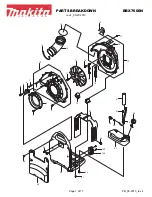
Subject to change without notice
34
B time base (2nd time base) /
Triggering after Delay
Please note instrument specific information in section “Con-
trols and readout”. The most important controls regarding
this mode are
A/ALT
-
B (30), DEL.TRIG. – VAR. (31), TIME/
DIV. (29), DEL. POS. (28)
and
TRS (13)
.
As mentioned before, triggering starts the time base sweep
and unblanks the beam. After the maximum X deflection to
the right, the beam is blanked and flies back to the (left) start
position. After the hold off time has elapsed the sweep is
started automatically by the automatic trigger or the next
trigger signal. In normal triggering mode the automatic trigger
is switched off and the sweep will only start on receipt of a
trigger signal. As the trigger point is always at the trace start
position, trace expansion in X direction with the aid of the
time base is limited to the display always from the trace start.
Parts of the signal to be expanded which are displayed near
the trace end (right side of the screen) are lost when the
time base speed is increased (time coefficient reduced). The
X expansion by 10 may also be used, but again the expansion
factor is limited. The B time base solves such problems.
First the A time coefficient should be in a suitable setting to
display a complete signal period. After setting the instrument
to alternate time base mode (A and B), the signal part to be
expanded must be selected with the aid of the intensified
sector on the A time base trace. The B time base deflection
coefficient should be at least a tenth of the A time coefficient.
Higher A/B ratios (e.g. A: 1ms/div, B: 1µs/div = 1000fold
expansion) result in a drastically reduced B trace intensity.
Within certain limits this can be compensated by the intensity
setting. To avoid high contrast between the A and B time
base trace, change from alternate (A and B) to B time base
mode. Then the A trace is invisible.
The start position of the intensified sector on the A trace can
be stated as the delay time. It is related to the A trace start
and the A time coefficient. The delay function delays the B
trace start by a variable time from the A trigger point. This
allows the sweep to begin on any portion of a signal (except
the first millimeters). If the display shows jitter, it is possible
to select triggering of the B time base after the elapsed delay
time.
AUTO SET
The instrument specific information regarding this function
is part of the section “Controls and Readout” paragraph
AUTO SET (2)
. The following description is relevant for analog
and digital operation. In digital operation
AUTO SET
automatically selects
REFRESH
signal capture if
ROLL
or
SINGLE
mode is active. The signal to be displayed must meet
the amplitude and frequency requirements of automatic
triggering, to enable a useful automatic instrument setting.
As also mentioned above all controls are electronically
selected with the exception of the
POWER
and calibrator
frequency (
CAL 1kHz/1MHz
) pushbuttons as well as the
FOCUS
and
TR
(trace rotation) control. Thus automatic signal
related instrument set up in
Yt
(time base) mode is possible.
In most cases no additional manual instrument setting is
required.
Briefly pressing the
AUTO SET
pushbutton causes the instru-
ment to switch over to the last Yt mode settings regarding
CH I
,
CH II
and
DUAL
. If the instrument was operated in
Yt
mode, the actual setting will not be affected with the
exception of ADD mode which will be switched off. At the
same time the attenuator(s) (
VOLTS/DIV
) are automatically
set for a signal display height of approx. 6 div in mono channel
mode or if in
DUAL
mode for approx. 4 div height for each
channel. This and the following explanation regarding the
automatic time coefficient setting assumes that the pulse
duty factor of the input signal is approx. 1:1.
The time deflection coefficient is also set automatically for a
display of approx. 2 signal periods. The time base setting
occurs randomly if complex signals consisting several
frequencies e.g. video signals are present.
AUTO SET sets the instrument automatically to the following
operating conditions:
• The input coupling is not affected while AC or DC is used,
but if GD was selected the last used input coupling (AC or
DC) will be chosen.
• Internal triggering (channel I or channel II)
• Automatic peak (value) triggering
• Trigger level in electrical midrange position
• Y deflection coefficient(s) calibrated
between 5mV/div and 20V/div
• A time base (deflection coefficient calibrated)
Alternate and B time base mode switched off
• AC trigger coupling (DC trigger coupling unchanged)
• X x10 magnifier switched off
• Automatic X and Y position settings
• Trace and readout visible.
If CURSOR measurement is active, AUTO SET causes
additional automatic settings. The restrictions already
mentioned must be taken into account:
Analog mode in combination with
∆∆∆∆∆
V
• automatic CURSOR supported voltage measurement.
• automatic assignment of the CURSOR lines to the signal,
which is used for triggering when DUAL mode is active.
Note
If no signal is applied or the trigger conditions can not
be met, the CURSOR line positions do not change.
The positioning accuracy depends on the signal frequency.
Digital mode in combination with
all CURSOR measurement modes
• automatic CURSOR supported voltage, time and frequency
measurement
• automatic assignment of the CURSOR lines to the signal,
which is used for triggering when DUAL mode is active.
Note
If no signal is applied or the trigger conditions can not
be met, the CURSOR line positions do not change.
Attention!
If a signal is applied with a pulse duty factor of ap-
prox. 400:1 or larger, an automatic signal display can
not be performed. The pulse duty factor causes too
low a Y deflection coefficient (sensitivity too high)
and too high a time deflection coefficient (time base
speed to slow) and results in a display in which only
the baseline is visible.
In such cases it is recommended to select normal triggering
and to set the trigger point approx. 0.5div above or below
the trace. If under one of these conditions the trigger indicator
LED is lit, this indicates the presence of a signal. Then both
the time coefficient and Y deflection coefficient should be
reduced. Please note that a reduction in intensity may occur,
which could result in a blank screen when the physical limits
are reached.
Auto set







































